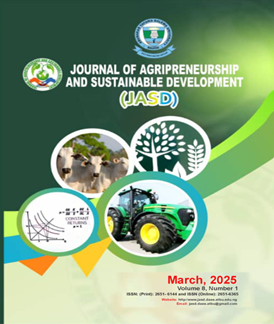LAND SUITABILITY APPRAISAL FOR SWEET POTATO (Ipomoea batatas) CULTIVTION ON A TOPOSEQUENCE AT OVIM ISIUKWUATO, SOUTH EAST NIGERIA
Keywords:
Cultivation, Properties, Soil, Suitability and ToposequenceAbstract
Land suitability assessment for sustainable cultivation of sweet potato was carried out on a toposequence at Ovim, Isiukwuato LGA, Abia State, Nigeria. A stratified random sampling technique was adopted and following the attributes of the terrain, the toposequence was delineated into upper, middle, lower slopes and valley bottom. Four profile pits (OVA, OVB, OVC and OVD) were then excavated; one on each of upper slope, middle slope, lower slope and valley bottom respectively. The pits were described and soil samples taken from genetic horizons were analyzed for physical and chemical properties. Results showed that OVA and OVB were deep (>18 cm) and well drained. Soil unit OVC was deep (165cm) but imperfectly while OVD was moderately deep (85cm) and poorly drained. The soils were strongly to moderately acidic (pH 5.3-5.9) with high base saturation (71.05 - 85.16). Organic matter contents were high for epipedons and low for the subsoils. The soils were low in ECEC averaging (6.26, 6.89, 7.65 and 6.55 cmolkg-1), available P (12.551, 12.88, 5.75 and 12.40 mgkg-1) and total N. (0.09, 0.06, 0.07 and 0.08 gkg-1), for OVA, OVB, OVC and OVD respectively. The suitability assessment by simple limitation confirmed that all the soil units were currently not suitable (N1) as the optimal performance were constrained by fertility (N1-f). In addition, OVD is limited by poorly drained condition (N1-fw) for the cultivation of sweet potato in the area. Adequate management of the soils through organic manuring and split application of NPK should be adopted. More so, proper drainage of OVD is necessary to control the inflow and outflow of water into the field. Otherwise, the unit could be devoted to cultivation of lowland rice.
Downloads
Downloads
Published
How to Cite
Issue
Section
License
Copyright (c) 2025 Journal of Agripreneurship and Sustainable Development

This work is licensed under a Creative Commons Attribution 4.0 International License.



